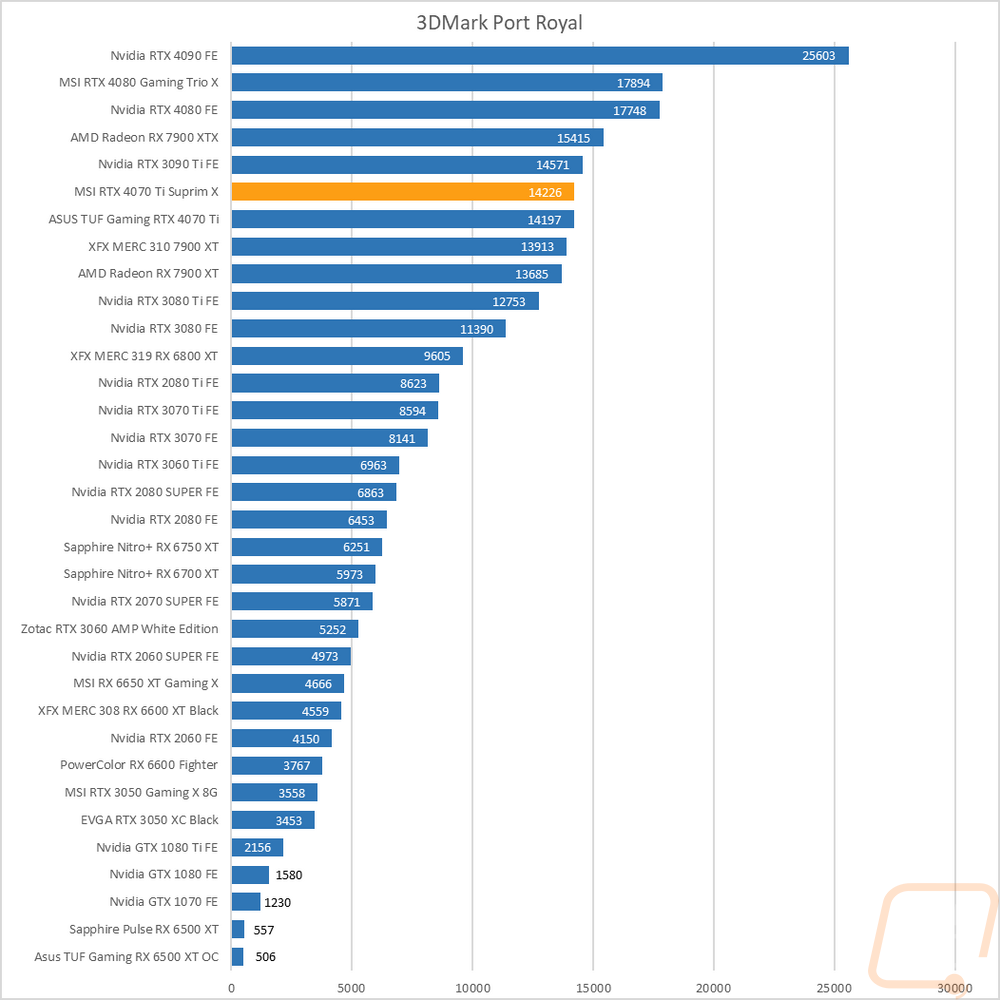RTX and DLSS
Being an RTX card I also like checking out the performance of some of Nvidia’s features. Namely the ray tracing performance and the performance improvements you can see by using DLSS combined with the tensor cores. My first test goes back to our synthetic benchmarks with 3DMark where I check out their Port Royal benchmark. This is the one test that does also have AMD Ray Tracing support which is great to get a look at how different cards including older non-RTX cards perform. The RTX 4070 Ti Suprim X improved on the TUF’s score by 29 points, not a big margin at all. This was also not enough to catch up to the 3090 Ti which is ahead in this test.

3DMark also has added a few feature tests, one being a look at DLSS performance. For this one, I have the resolution set to 1440p and DLSS 2.0 turned on. I then have run the test on every card supported to get a comparison of how their test performs with and without DLSS. The RTX 4070 Ti Suprim X gained an FPS over the TUF 4070 Ti and both sit behind the RTX 4080 but ahead of the 3090 Ti in the DLSS on results but behind the 3090 Ti with DLSS off. I did a second set of tests at 4K across all three versions of DLSS and twice with the new DLSS 3 to test the performance and quality settings. The idea with this test was to check out the performance difference between the different DLSS versions, but I did also include performance numbers from a few cards for comparison as well. No matter the card it is impressive that DLSS 3 can match DLSS 2’s performance when running on the quality setting and the performance gap going from 2 to 3 is big as well. With the RTX 4070 Ti Suprim X, it improved performance from 80.96 FPS to 105.53 FPS which is an improvement of 30%.


I then jumped into game tests, this time with Watch Dogs: Legion. For this one, I wanted to get an idea of the performance you will see when taking advantage of Nvidia’s RTX and DLSS features. I tested at 4k with the ultra detail setting and with ultra being the setting for DLSS and RTX when they are on as well. I then test with no RTX or DLSS on and then with RTX DLSS on and off and on together. Here the RTX 4070 Ti Suprim X comes in just behind the 3090 Ti but more importantly it shows that turning RTX dropped performance from 69 FPS down to 37 but pairing it with LSS put it at 90 FPS which is faster while also getting ray-traced graphics. Or if you want, running only DLSS nearly puts the average FPS up over the 120 high refresh rate range with it averaging 119 FPS which is two FPS higher than the TUF 4070 Ti did.

Next, I wanted to check out the performance in Metro Exodus which we have used for testing for a long time now. This test is similar as well with it set to 4K and Ultra detail, I use the included benchmark to test DLSS and RTX individually and then with them both on and both off to give us a look at overall frame rates depending on which direction you go. I should point out that this is using the Enhanced Edition where our normal benchmark uses the standard version for testing with AMD but that version DLSS no longer works. That said you can see how big of an improvement running DLSS goes with it nearly doubling the performance.

Next, I tested using a benchmark based on the game Boundary. For this one, I wanted to see how all of the different DLSS settings would perform, including turning it off completely. This is run using the free benchmark and with the resolution set to 4k and RTX on. Like with the TUF 4070 Ti, the RTX 4070 Ti Suprim X outperformed but the extra overclock was enough to keep it ahead of the 3090 Ti even at the highest quality setting where the TUF card didn’t. This does a good job of showing the range of performance you can see depending on what settings you run. The RTX 4070 Ti Suprim X runs as low as 27 FPS and as high as 128.6 FPS.

The last tests were done in a benchmark based on the game Bright Memory with their free steam benchmark. This is similar to the previous Boundary test only it is looking at RTX settings individually with the resolution set to 4K and DLSS is set to the balanced setting. Here the RTX 4070 Ti Suprim X came in below the RTX 3090 Ti but ahead of the 3080 Ti. This test shows the range that DLSS detail settings can range in performance and that is before you even start to mix in things like frame generation. The RTX 4070 Ti Suprim X ranges from 53 FPS up to 82 depending on what you run.



